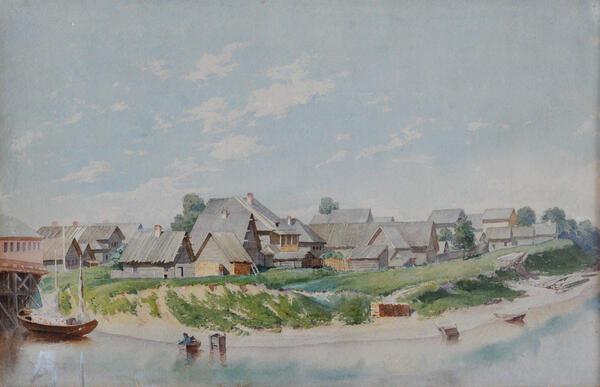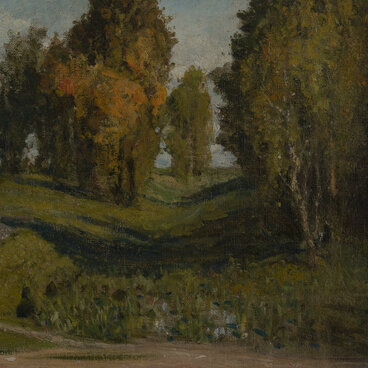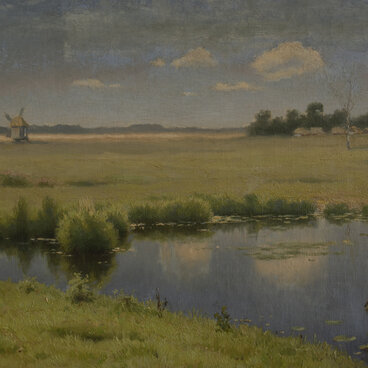The watercolor “Tosno Village” from the collection of the Ostrogozhsk Museum was painted by the great landscape artist Nil Alexeyevich Gogolinsky. This delicate painting is filled with the artist’s warmth towards the Russian village: he depicted a sunny summer day, with only a few clouds in the blue sky, tidy houses on the steep riverbank, cramped courtyards, a wooden bridge nearby, and lots of details showing the everyday life of peasants.
Most painters of the 19th and 20th centuries received formal education at the Imperial Academy of Arts. Nil Gogolinsky also started his career in art this way. The talented watercolorist graduated from the Academy of Arts in 1869. As a student, he was awarded two Grand Silver Medals for the high quality of his paintings and drawings. After mastering the basics of fine arts, the talented student received a title of a classed artist, 2nd degree.
Nil Gogolinsky’s favorite genre was landscape. Having determined his style, he regularly participated in the exhibitions of the Society of Russian Watercolorists. The beginning artist appreciated the main advantage of watercolors — their transparency. Admirers of the watercolor technique have always praised its beauty and complexity, as well as its poetry, reminiscent of a lyric verse or an entrancing melody. One artist jokingly said that a watercolorist should work slowly but quickly.
There were many watercolorists among French artists, but Russian painters also achieved impressive heights in this technique, introducing their own innovations. For example, Mikhail Vrubel painted with separate spots, leaving narrow gaps between them which he later filled with one color, most often light blue. Nil Gogolinsky shared the principle formulated by a French watercolorist, “An artist cannot achieve wonderful colors without making the white of the paper do its work, not simply by allowing it to show through, but also by leaving it in various proportions around each spot.”
Still, the artist’s main goal was to show the beauty and individuality of various landscapes. Nil Gogolinsky was one of the first Russian painters to visit the village of Talashkino, Smolensk Governorate, which was considered the center of Russian cultural life since the late 19th century. According to its cultural significance, this village was considered equal to Abramtsevo.
Most painters of the 19th and 20th centuries received formal education at the Imperial Academy of Arts. Nil Gogolinsky also started his career in art this way. The talented watercolorist graduated from the Academy of Arts in 1869. As a student, he was awarded two Grand Silver Medals for the high quality of his paintings and drawings. After mastering the basics of fine arts, the talented student received a title of a classed artist, 2nd degree.
Nil Gogolinsky’s favorite genre was landscape. Having determined his style, he regularly participated in the exhibitions of the Society of Russian Watercolorists. The beginning artist appreciated the main advantage of watercolors — their transparency. Admirers of the watercolor technique have always praised its beauty and complexity, as well as its poetry, reminiscent of a lyric verse or an entrancing melody. One artist jokingly said that a watercolorist should work slowly but quickly.
There were many watercolorists among French artists, but Russian painters also achieved impressive heights in this technique, introducing their own innovations. For example, Mikhail Vrubel painted with separate spots, leaving narrow gaps between them which he later filled with one color, most often light blue. Nil Gogolinsky shared the principle formulated by a French watercolorist, “An artist cannot achieve wonderful colors without making the white of the paper do its work, not simply by allowing it to show through, but also by leaving it in various proportions around each spot.”
Still, the artist’s main goal was to show the beauty and individuality of various landscapes. Nil Gogolinsky was one of the first Russian painters to visit the village of Talashkino, Smolensk Governorate, which was considered the center of Russian cultural life since the late 19th century. According to its cultural significance, this village was considered equal to Abramtsevo.



